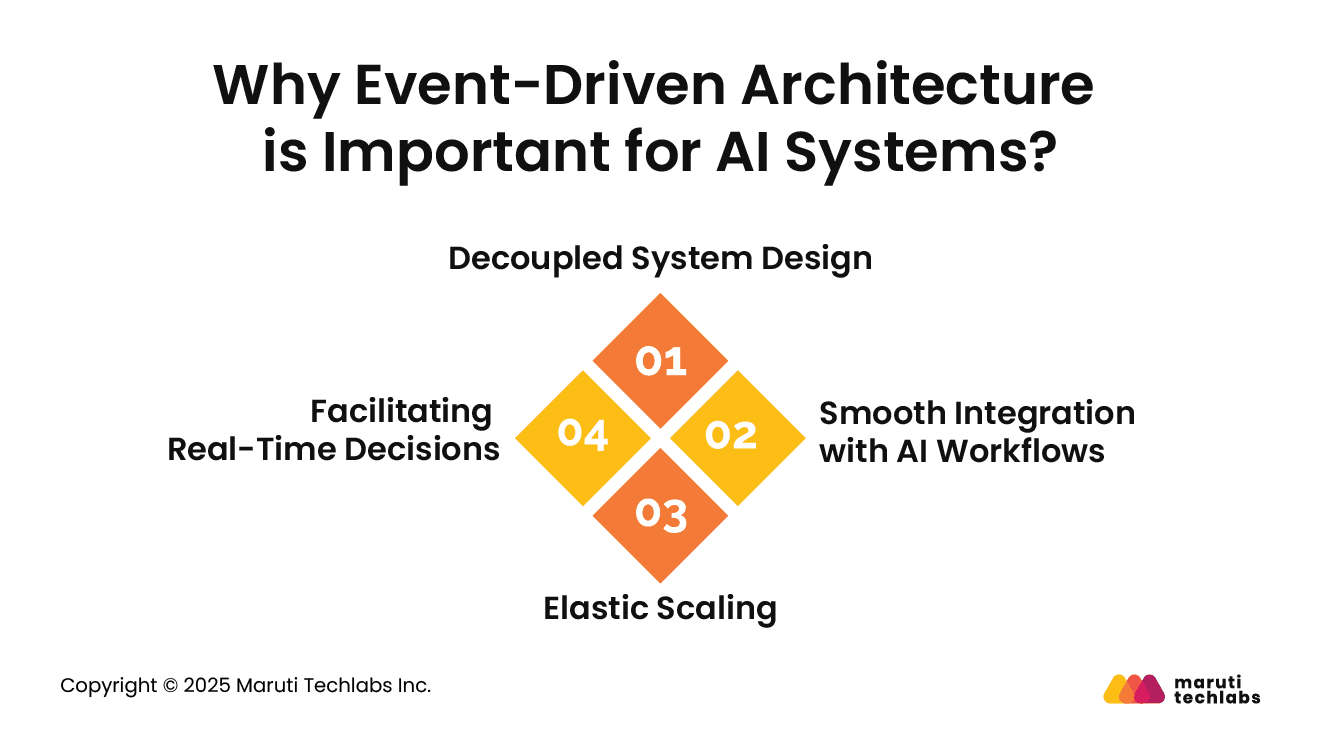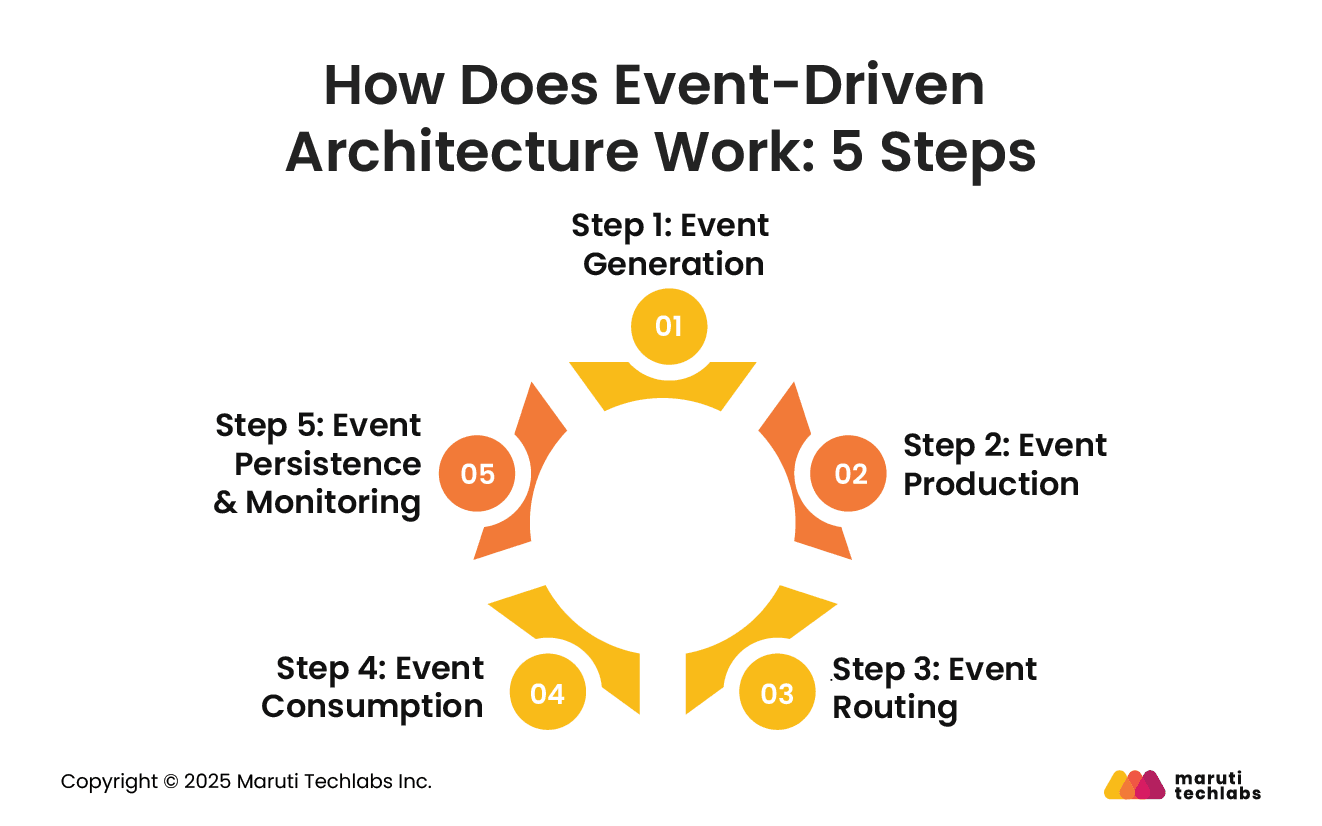

Why AI-Powered Event-Driven Architectures Are Game-Changers Now?






Real-time matters in AI because milliseconds can make or break use cases like fraud detection, logistics, autonomous systems, and hyper-personalized marketing. Delayed AI is basically useless.
Event-Driven Architecture (EDA) enables this by processing events as they occur, dramatically reducing latency and enabling more effective, competitive AI.
AI agents promise to deliver autonomous problem-solving, adaptive workflows, and scalable operations, but the fundamental enabler isn’t more innovative models; it’s infrastructure.
Event-Driven Architecture (EDA) supports AI agents by ensuring real-time access to data, seamless integration across systems, and a decoupled design that allows agents to react autonomously and scale reliably. This shift toward EDA is fundamental for AI agents to thrive in enterprise environments, truly.
In this article, we discuss the importance of EDA for AI applications, how AI enhances relevance for event streams, how it works, and industry-specific examples.
Event-Driven Architecture (EDA) is a modern design pattern made up of small, decoupled services that publish, consume, or route events. An event is simply a change in state or an update within a system.
Examples of events include placing an item in a shopping cart, uploading a file to cloud storage, or marking an order as ready for shipment. Events may carry full details (e.g., item name, price, quantity) or just an identifier (e.g., “Order #8942 shipped”) that links to additional information.
Unlike traditional request-driven systems, where services directly call one another, EDA promotes loose coupling between producers and consumers. This separation enables systems to be more scalable, flexible, and easier to update or deploy without affecting other components.
Here is a list of essential benefits offered by EDA for AI systems.
Event producers and consumers act like a post office system. Producers (like Amazon S3) generate events, similar to dropping letters in a mailbox.
Consumers (like Amazon Lambda) and event consumers, i.e., people who pick up those letters and process them.
Producers and consumers have no dependency on each other. So, producers can generate as many events as they want, and consumers can change, scale, or even be replaced without affecting the producers.
This prevents system failure if issues arise in any part of the system. This decoupling enables the system to be faster, safer, and easier to improve.
EDA takes a modular approach. AI functions, such as inference, preprocessing, summarization, or action-taking, work as independent services.
All services are triggered when an event is generated. This eliminates the need for a centralized controller for event management. This facilitates independent scaling or changes of services without a centralized coordination logic.

AI events don’t follow a steady flow but often come as a sudden burst. EDA supports this by not wasting idle resources and decreasing costs. Here’s how this works:
Events allow AI services to respond immediately to user or system requests. Here are a few examples of the same.
EDA helps develop responsive systems. An event is just an indicator that something has happened, like a user has logged in. The system can respond to the event, but the generated event lacks context.
For instance, when a user logs in, should they be directed to the home page, share current offers, or consider it a suspicious activity? The event alone isn’t capable of deciding the next best step.
This is where AI comes in. Artificial Intelligence can analyze event streams, such as too many login attempts, transactions, or clicks. This analysis helps them uncover anomalies, patterns, and intent. As compared to raw events that are noisy and isolated, AI can proficiently interpret and add meaning to them.
So, as opposed to reacting to single events, EDA powered with AI can learn what users need, spot unusual behavior, and adapt in real-time, making them more useful and smarter.
Apps function either as event producers or consumers or both in an event-driven architecture. An event is transmitted in the form of a message by producers to a router. This keeps them in a chronological order.
From here, consumers ingest the message and process it to trigger the required action.

Let’s understand the process of how an EDA works with an e-commerce example.
An event is generated within the system. This prompts a change in the system, like a user adding items to a shopping cart. Here, the system’s state observes a change with an event, namely ‘ItemAddedToCart’.
Then, the ‘event producer’, i.e., the component where this change has occurred, creates an event message describing this change. In this example, the cart service is the event producer. It generates a message with details such as user ID, item ID, and timestamp.
The event is forwarded to an event router or broker, such as Kafka or Amazon EventBridge. It learns the event type and routes it to the appropriate consumer. These include recommendation engines (to suggest related items) and inventory management (to update stock levels).
Event consumers receive the message of the created event and start preparing for the required action, like updating a user’s order history. For instance, the inventory service addresses the event by decreasing the stock count for the added item.
As a last step, the events are stored for analytical or auditing purposes. This facilitates the system’s monitoring and reaction to events both retrospectively and in real-time.
In this example, the event log stores the ‘ItemAddedToCart.’ This enables the system to plan future inventory by analyzing trends, debugging events, or auditing shopping cart activities.
Here are a few examples of how industries are leveraging EDA with AI.
When EDA is equipped with AI, it can examine purchase or browsing behaviors to create hyper-personalized promotions or recommendations. AI processes digital behavioural data to analyze intent to buy and uses events to share offers that are highly relevant to the user.
It collects multiple high-value attributes and deduces purchase intent. This creates an efficient sales process by sharing promotions that are likely to convert, utilizing this automated flow.
AI models can identify medical conditions early on without human review, providing a real-time analysis of the output. The alerts can also be shared directly with the staff. This approach lowers risk while accelerating intervention. This is all possible due to event-based architecture, which at times updates data faster than human reactions.
A security workflow is triggered instantly when a user’s phone has a sudden international transaction while the user is present in their home country.
Sensors can detect adverse weather conditions, increased demand, or delivery delays. Reading these signals, AI can quickly suggest alternate routes or plans that can help shipments reach on time.
AI is and will be an integral part of the IT revolution, and architectures must evolve accordingly. This shows a demand for systems that can handle complexity and scale.
A survey from Forum Ventures shows that nearly 48% of enterprises are already adopting agentic solutions, with an additional 33% actively exploring solutions.
EDA is crucial if you plan to create systems that are resilient, scalable, and flexible. It decouples components, offers real-time workflows, and ensures the smooth integration of agents into your established ecosystems.
By facilitating seamless data flow between systems, EDA enables AI to ingest, process, and act on large amounts of data in real-time. It removes the rigidity of traditional architectures, simplifying integration.
A switch to EDA isn’t a technological upgrade, but a strategic investment that supports innovation, reduces risks, and helps businesses respond faster to market demands.
Event-Driven Architecture (EDA) is foundational for modern AI. Its real-time, loosely coupled design enables systems to react instantly, scale effectively, and adapt dynamically.
When AI enriches event streams with context, recognizing patterns, predicting anomalies, and inferring intent, systems shift from being merely reactive to truly intelligent and proactive.
Event-Driven Architecture brings scalability and resilience by allowing services to function independently, so failures don’t disrupt the entire system. With AI integration, it enables instant, context-aware processing, triggering precise actions like fraud detection, order updates, or customer engagement.
Real-world applications span various industries, with retail utilizing real-time promotions, finance combating fraud instantly, and logistics rerouting shipments based on weather or demand shifts.
At Maruti Techlabs, we blend deep AI expertise with modern EDA best practices to build systems that aren’t just fast but intelligent. We craft scalable, resilient EDAs optimized for your specific needs, using platforms like Kafka, WSO2, and KrackenD.
Our solutions interpret streams in real time, recognizing patterns, anomalies, and user intent to power adaptive, context-rich workflows. Backed by Custom AI Development, we prioritize flexibility and performance, working closely with stakeholders to deliver and refine systems that evolve with your business.
Get in touch with us today to see how our experts can help equip your traditional systems with event-driven architecture powered by AI.
Want to understand where your business stands before adopting such technologies? Try our AI Readiness Assessment Tool to evaluate your current capabilities and identify the right next steps toward AI-driven transformation.
Specialized Cloud Consultants, integration engineers, and AI solution providers can handle JMS queue migrations. They modernize legacy systems into scalable, event-driven AI architectures by leveraging platforms such as Kafka, Pulsar, or AWS EventBridge, while ensuring minimal disruption to existing systems
Event-Driven Architecture (EDA) is a system design where services communicate through events, state changes, or updates. For example, when a customer places an online order, an “order created” event triggers downstream actions like payment processing and shipping notifications.
Microservices break applications into independent, self-contained services communicating via APIs. Event-Driven Architecture focuses on asynchronous communication where events trigger actions. While microservices define the system's structure, EDA defines how those services interact in real-time for responsiveness and scalability.
Kafka itself is not an architecture but a distributed event-streaming platform. It enables the building of event-driven architectures by publishing, subscribing, storing, and processing event streams in real-time, making it a key enabler for scalable event-driven AI systems.


